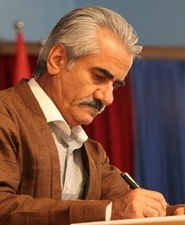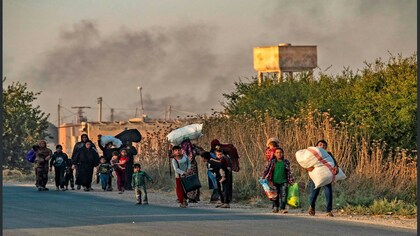What are Iran’s Goals in Iraq?
15:01 - 24 March 2015

By: Mustafa Hijri
Currently, Iranian forces alongside with Shiite militias, who are funded and controlled by Iran, are fighting the Islamic State in Tikrit and other places in Iraq. The Islamic State, or ISIS, gained international attention following the seizure of Mosul, Iraq’s second largest city. However, more than a year before ISIS (Daesh) seized control of Mosul, our party publicly warned, based on credible intelligence, that Iranian agents had infiltrated ISIS and that if unchecked, the expansion of this terrorist group would serve Iranian interests in Syria and beyond. Media outlets in the Gulf countries, citing their own intelligence sources, also warned of this scenario.
To some analysts and policymakers in the West, these claims might seem puzzling. Some might even dismiss them as yet another conspiracy theory emanating from the Middle East.
However, aside from the intelligence on Iran’s infiltration of ISIS, past Iranian actions and the consequences of the rise of ISIS can be cited in support of those claims.
First, Iran’s support and funding of various terrorist groups throughout the Middle East is well known. For example, in a report by the Library of Congress on Iran’s Minister of Intelligence and Security, it is stated that Iran “provides financial, material, technological, or other support services to Hamas, Hezbollah, and al-Qaeda in Iraq (AQI), all designated terrorist organizations under U.S. Executive Order 13224.”
While the Iranian regime adheres to a fundamentalist interpretation of Shiite Islam and is in conflict with the Sunnis, Tehran has on numerous occasions supported terrorist Sunni groups to destabilize strategically important countries in the Middle East. Iranian infiltration of and support for ISIS should therefore come as no surprise, although Iranian forces are fighting the group in Iraq.
Second, once the Iranian regime and its Syrian ally realized that secular forces who were taking the lead in the fight against the combined forces of Assad, Iran and Hezbollah could become a viable opposition force, they capitalized on ISIS’s split from al-Qaida and in various ways made sure that ISIS – which had set out to eliminate all other opposition groups – could become the dominant group in Syria. At the same time, Iraq’s former prime minister, Nouri al-Maliki, released many members of ISIS from prison that subsequently joined the group in Syria. Iran, the Shiite-dominated government in Iraq and the Assad regime in Syria were fearful that the secular forces in Syria could become an ideologically attractive ally for the Western powers.
To discredit the Syrian opposition and paint it as a radical Sunni movement dominated by a vicious terrorist organization like ISIS, their aim was to compel the Western powers to reconsider their plans for regime change and accept the Assad regime as the lesser evil compared to a possible ISIS takeover in Syria. To this end, Iran and the Assad regime gave ISIS free leeway to establish its control over Raaqah in Syria, from where it later could expand into other parts of Syria and, as it turned out, even Iraq. Although this too might sound as bizarre, reports had for some time indicated that the expansion of ISIS was indeed facilitated by Iran and Syria. For example, the Washington Post reported on June 10, 2014, the following: “Moderate rebel groups complain that ISIS’s rise has been aided by the relative disinterest shown by Syrian government forces in the areas under the group’s control, which are rarely subjected to airstrikes and bombardment. That has helped the group set up its own version of a government.”
Third, irrespective of whether one finds existing intelligence in that regard as credible, the rise and expansion of ISIS have as a matter of fact served the interests of the Islamic regime in Iran. In other words, irrespective of Iranian intentions and schemes, the consequences of ISIS’s emergence as a formidable fighting force in Syria and, later, its expansion into Iraq has served the interests of the regime in Tehran.
Although Iran is allied with some Shiite groups in Iraq, the regime in Tehran has defined its strategic interests in Iraq in three ways. The first is to preclude the emergence of a federal democracy in Iraq that is stable and economically and politically strong enough to become a regional power with the capacity to block Iranian hegemony. Although the regime in Tehran is rhetorically committed to “friendly” relations with Iraq, it pursues a policy of divide and conquer toward its Shiite-dominated neighbor. The second strategic objective of Iran in Iraq is to make sure that democracy does not take root. In fact, Iran’s concerted effort is to make sure that democracy is associated with chaos and instability. The third Iranian strategic interest in Iraq is to undermine the Kurdistan regional government and make sure that the Kurds do not progress further. Iran is fearful of the Kurdistan regional government and its drive toward independence because of its demonstration effect on other parts of Kurdistan.
It is noteworthy that ISIS first stated that it would seize Baghdad once it consolidated itself in Mosul. However, ISIS instead attacked Iraqi Kurdistan. This came at a time when the Iraqi-Kurdish leadership called for a referendum on independence.
In short, ISIS’s expansion into Iraq, which was facilitated by Iran, the Assad regime and the Maliki government, has made Iraq even weaker and thus more amenable to Iranian control. The Iraqi army has been reduced substantially. Meanwhile, Shiite militias that answer to Iran have become the most powerful military forces in Iraq. These militias terrorize the Sunni population and thus perpetuate the sectarian conflict between Shiites and Sunnis. In fact, ISIS has helped the Shiite government in Iraq in this regard by eliminating prominent figures and tribal leaders within the Sunni community, thus making the Sunnis even more vulnerable. At the same time, the Kurdistan region’s war with ISIS has drained the limited resources of the Kurdish government, resulted in hundreds of thousands of internally displaced persons, several thousand dead and injured Peshmergas, as well as other dangerous consequences for Iraq at large and the Kurdistan region in particular.
In the midst of all this, there are naïve journalists, pundits and even some government officials in the Western world who have bought into the propaganda by the Iranian regime’s lobby that it is a force for “stability” in the region. The regime in Tehran, which is the major source of instability throughout the Middle East, is painted in some circles as a possible stabilizing factor in Iraq and elsewhere.
However, as recently warned by General David H. Petraeus, former commander of U.S. forces in Iraq, the strategic threat to stability, democracy and western interests in Iraq and Syria is the Iranian regime. According to Gen. Petraeus, Iran is on the verge of creating a terrorist proxy similar to Hezbollah in Lebanon, thus posing a strategic threat to the balance of power in the region.
In spite of the economic siege on Iraqi Kurdistan, the Kurdish government and the brave Peshmerga forces have managed to not only withstand the multiple military attacks by ISIS, but also to push back this terrorist group from Kurdish territory. Once ISIS is defeated, a war between the Peshmerga Forces and the militias of Iran in Iraq is likely. This is likely to start in Kirkuk and other strategically important places.
To prevent a situation where the West has to decide whether to fight a war with Iran’s proxies in Iraq, the United States and its allies should increase their support for the Kurdistan region. Only through a visible presence in combination with financial and military support for the Kurdistan region can the West undermine Iran’s drive for hegemony in the Middle East.
Opinions contained within the article are of the author and not necessarily representative of Kurdpa editorial views.
Currently, Iranian forces alongside with Shiite militias, who are funded and controlled by Iran, are fighting the Islamic State in Tikrit and other places in Iraq. The Islamic State, or ISIS, gained international attention following the seizure of Mosul, Iraq’s second largest city. However, more than a year before ISIS (Daesh) seized control of Mosul, our party publicly warned, based on credible intelligence, that Iranian agents had infiltrated ISIS and that if unchecked, the expansion of this terrorist group would serve Iranian interests in Syria and beyond. Media outlets in the Gulf countries, citing their own intelligence sources, also warned of this scenario.
To some analysts and policymakers in the West, these claims might seem puzzling. Some might even dismiss them as yet another conspiracy theory emanating from the Middle East.
However, aside from the intelligence on Iran’s infiltration of ISIS, past Iranian actions and the consequences of the rise of ISIS can be cited in support of those claims.
First, Iran’s support and funding of various terrorist groups throughout the Middle East is well known. For example, in a report by the Library of Congress on Iran’s Minister of Intelligence and Security, it is stated that Iran “provides financial, material, technological, or other support services to Hamas, Hezbollah, and al-Qaeda in Iraq (AQI), all designated terrorist organizations under U.S. Executive Order 13224.”
While the Iranian regime adheres to a fundamentalist interpretation of Shiite Islam and is in conflict with the Sunnis, Tehran has on numerous occasions supported terrorist Sunni groups to destabilize strategically important countries in the Middle East. Iranian infiltration of and support for ISIS should therefore come as no surprise, although Iranian forces are fighting the group in Iraq.
Second, once the Iranian regime and its Syrian ally realized that secular forces who were taking the lead in the fight against the combined forces of Assad, Iran and Hezbollah could become a viable opposition force, they capitalized on ISIS’s split from al-Qaida and in various ways made sure that ISIS – which had set out to eliminate all other opposition groups – could become the dominant group in Syria. At the same time, Iraq’s former prime minister, Nouri al-Maliki, released many members of ISIS from prison that subsequently joined the group in Syria. Iran, the Shiite-dominated government in Iraq and the Assad regime in Syria were fearful that the secular forces in Syria could become an ideologically attractive ally for the Western powers.
To discredit the Syrian opposition and paint it as a radical Sunni movement dominated by a vicious terrorist organization like ISIS, their aim was to compel the Western powers to reconsider their plans for regime change and accept the Assad regime as the lesser evil compared to a possible ISIS takeover in Syria. To this end, Iran and the Assad regime gave ISIS free leeway to establish its control over Raaqah in Syria, from where it later could expand into other parts of Syria and, as it turned out, even Iraq. Although this too might sound as bizarre, reports had for some time indicated that the expansion of ISIS was indeed facilitated by Iran and Syria. For example, the Washington Post reported on June 10, 2014, the following: “Moderate rebel groups complain that ISIS’s rise has been aided by the relative disinterest shown by Syrian government forces in the areas under the group’s control, which are rarely subjected to airstrikes and bombardment. That has helped the group set up its own version of a government.”
Third, irrespective of whether one finds existing intelligence in that regard as credible, the rise and expansion of ISIS have as a matter of fact served the interests of the Islamic regime in Iran. In other words, irrespective of Iranian intentions and schemes, the consequences of ISIS’s emergence as a formidable fighting force in Syria and, later, its expansion into Iraq has served the interests of the regime in Tehran.
Although Iran is allied with some Shiite groups in Iraq, the regime in Tehran has defined its strategic interests in Iraq in three ways. The first is to preclude the emergence of a federal democracy in Iraq that is stable and economically and politically strong enough to become a regional power with the capacity to block Iranian hegemony. Although the regime in Tehran is rhetorically committed to “friendly” relations with Iraq, it pursues a policy of divide and conquer toward its Shiite-dominated neighbor. The second strategic objective of Iran in Iraq is to make sure that democracy does not take root. In fact, Iran’s concerted effort is to make sure that democracy is associated with chaos and instability. The third Iranian strategic interest in Iraq is to undermine the Kurdistan regional government and make sure that the Kurds do not progress further. Iran is fearful of the Kurdistan regional government and its drive toward independence because of its demonstration effect on other parts of Kurdistan.
It is noteworthy that ISIS first stated that it would seize Baghdad once it consolidated itself in Mosul. However, ISIS instead attacked Iraqi Kurdistan. This came at a time when the Iraqi-Kurdish leadership called for a referendum on independence.
In short, ISIS’s expansion into Iraq, which was facilitated by Iran, the Assad regime and the Maliki government, has made Iraq even weaker and thus more amenable to Iranian control. The Iraqi army has been reduced substantially. Meanwhile, Shiite militias that answer to Iran have become the most powerful military forces in Iraq. These militias terrorize the Sunni population and thus perpetuate the sectarian conflict between Shiites and Sunnis. In fact, ISIS has helped the Shiite government in Iraq in this regard by eliminating prominent figures and tribal leaders within the Sunni community, thus making the Sunnis even more vulnerable. At the same time, the Kurdistan region’s war with ISIS has drained the limited resources of the Kurdish government, resulted in hundreds of thousands of internally displaced persons, several thousand dead and injured Peshmergas, as well as other dangerous consequences for Iraq at large and the Kurdistan region in particular.
In the midst of all this, there are naïve journalists, pundits and even some government officials in the Western world who have bought into the propaganda by the Iranian regime’s lobby that it is a force for “stability” in the region. The regime in Tehran, which is the major source of instability throughout the Middle East, is painted in some circles as a possible stabilizing factor in Iraq and elsewhere.
However, as recently warned by General David H. Petraeus, former commander of U.S. forces in Iraq, the strategic threat to stability, democracy and western interests in Iraq and Syria is the Iranian regime. According to Gen. Petraeus, Iran is on the verge of creating a terrorist proxy similar to Hezbollah in Lebanon, thus posing a strategic threat to the balance of power in the region.
In spite of the economic siege on Iraqi Kurdistan, the Kurdish government and the brave Peshmerga forces have managed to not only withstand the multiple military attacks by ISIS, but also to push back this terrorist group from Kurdish territory. Once ISIS is defeated, a war between the Peshmerga Forces and the militias of Iran in Iraq is likely. This is likely to start in Kirkuk and other strategically important places.
To prevent a situation where the West has to decide whether to fight a war with Iran’s proxies in Iraq, the United States and its allies should increase their support for the Kurdistan region. Only through a visible presence in combination with financial and military support for the Kurdistan region can the West undermine Iran’s drive for hegemony in the Middle East.
Opinions contained within the article are of the author and not necessarily representative of Kurdpa editorial views.



